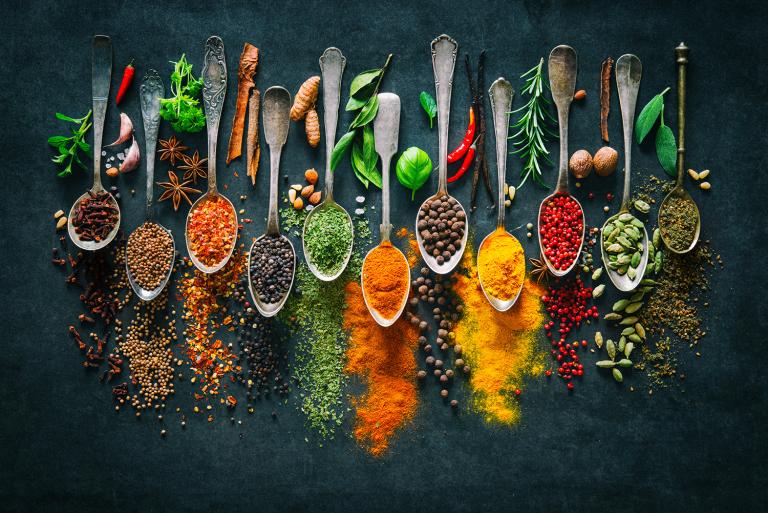Powerful plant compounds in these seasonings help fight cancer, diabetes, and heart disease, while working to relieve pain and the discomforts associated with seasonal bouts of colds and flu.
That’s why you’ll find many of your favorite seasonings on the supplement shelf and even in personal care products.
Fresh Herbs and Spices Are More Potent
For best results, store culinary herbs and spices in airtight containers away from heat and humidity.
To be sure what’s in your spice rack is fresh, rub a little seasoning between your fingers. If the aroma is noticeably pleasant, it’s probably still fresh.
Toss any musty spices or those that smell like old grass clippings. In general, replace any seasoning after one year.
Ways to Use Herbs and Spices
-
Add New Ingredients to Old Recipes
For example, add a little cinnamon along with basil and oregano to your tomato dishes. Mixing spices in curries, rubs, and other traditional combinations may increase their potency. Their antioxidant activity survives even boiling for 30 minutes.
Many herbs and spices—like ginger, oregano, and thyme—help fight foodborne pathogens to prevent those annoying digestive “bugs” that no one wants to deal with.
Others, like turmeric (containing curcumin, which gives curry its yellow color), have been shown to be protective against alcohol-related liver damage.
-
Drink Herbal Tea
In addition to culinary uses for these healing botanicals, herbal teas are a great way to enhance your health. Try drinking two cups of antioxidant-rich herb teas daily to help slow the aging process.
Enjoy ginger, lemon balm, oregano, peppermint, rosemary, sage, spearmint, and thyme in teas.
-
Make Your Own Herbal Infusions
Consider making your own herbal infusions using fresh spices like cardamom:
- Lightly smash 1 1⁄2 tablespoons of cardamom pods.
- Put in a teapot, cover with 3 cups boiling water.
- Steep for 10 minutes.
This spicy tea will kill bad breath, ease nasal congestion, and soothe an upset tummy as it relieves gas.
-
Try Botanical Infusions
While you’ll find herbs and spices in natural drinks, botanical infusions (also called tisanes) are also making their way onto store shelves.
Lighter in taste and gentler in their actions, these beverages make a fresh—and refreshing—way to support your health.
Popular Healing Herbs and Spices
These are some of our favorite natural remedies.
| Plant | Scientific Name | Uses | Notes |
|---|---|---|---|
| Cardamom | Elettaria cardamomum | Germany’s Commission E approves its internal use for indigestion. | Contains cineole, an antiseptic that’s effective against bad breath, congestion, and flatulence. |
| Cayenne | Capsicum spp. | Antibacterial that fights food poisoning and helps prevent cardiovascular disease and respiratory infections. | Topical creams block pain in arthritis, psoriasis, and shingles, or mix ¼ to ½ teaspoon cayenne pepper in a cup of warm water; drink after meals. |
| Cinnamon | Cinnamomum spp. | Antimicrobial and antioxidant that also improves insulin sensitivity while lowering cholesterol and triglycerides. | Even 1/2 tsp twice daily before meals can lower blood sugar and cholesterol levels. |
| Clove | Syzygium aromaticum | High in antioxidants; also antiseptic and antispasmodic. | Oil is safe and effective for toothache. |
| Coriander | Coriandrum sativum | Germany’s Commission E approves its internal use for indigestion and flatulence. | Topical use in cosmetics as a fragrance component. |
| Eucalyptus | E. globulus | Antiseptic and decongestant useful in aromatherapy and steam inhalation; also available in capsules and teas. | Do NOT take oil internally; topical applications ease sore muscles. |
| Garlic | Allium sativum | Antimicrobial beneficial for colds and nasal congestion; fights clogged arteries and lowers blood pressure. May also help fight cancer, treat diabetes, Raynaud’s disease, and yeast infections. | Can counteract probiotics, so take separately. For athlete’s foot, crush several cloves in warm water and a little rubbing alcohol and soak feet; topical use of garlic oil helps relieve earache. |
| Ginger | Zingiber officinale | Antimicrobial useful in food preparation and oral health; antioxidant that significantly lowers lipids, aids circulation, and may help relieve arthritic knee pain. | Effective for morning and motion sickness. This popular spice has been safely used medicinally for millennia. |
| Licorice | Glycyrrhiza spp. | Take standard licorice for respiratory infections or use topically; use deglycyrrhizinated (DGL) products for digestive problems. | Most widely used herbal remedy in the world after ginger. |
| Myrrh | Commiphora myrrha | Aromatic resin; antiseptic tincture for canker sores, cuts, and gum disease. | Also found in toothpastes; inhaled, its volatile oils relieve congestion. |
| Oregano | Origanum vulgare | Antimicrobial effective against foodborne pathogens, even antibiotic-resistant bacteria; may be useful against several cancers. | Has 20 times the antioxidant activity of other herbs; a potent anti-inflammatory. |
| Peppermint | Mentha x piperita | Antibacterial and antispasmodic; helps dissolve gallstones. | Applied topically, relaxes muscles and relieves pain; do NOT ingest or apply pure oil. |
| Rosemary | Rosmarinus officinalis | Contains phenols with anticarcinogenic, anti-inflammatory, and antioxidant benefits. | In some research, helps fight cataracts and possibly Alzheimer’s disease. |
| Sage | Salvia officinalis | Germany’s Commission E approves its internal use for upset stomach and externally for upper respiratory inflammation; may enhance memory. | In addition to sage’s culinary benefits, its oil is used in natural perfumes and soaps. |
| Star Anise | Illicium verum | Germany’s Commission E approves its use as a bronchial expectorant and to soothe gastrointestinal complaints. | Safe for food use. |
| Thyme | Thymus vulgaris | Antimicrobial effective against a variety of bacteria and fungi; useful for coughs | Used topically for minor arthritis and in sweet-smelling personal care products. |
| Turmeric | Curcuma longa | Contains curcumin that reduces inflammation and risk for Type 2 diabetes; may help fight Alzheimer’s disease, Crohn’s disease, depression, heart failure, rheumatoid arthritis, and tumor growth. | Black pepper greatly improves turmeric’s absorption in the body. Also used topically in Ayurvedic lotions for dry or inflamed skin, sores, and wounds. |

